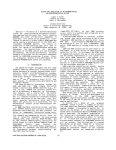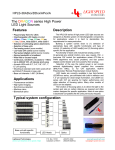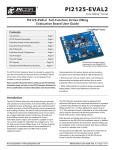Download Test Jig OPM-JIG2_LXX - User Manual
Transcript
1 Test Jig OPM-JIG2_LXX - User Manual Document date: 2July 2012 Contents: 1. 2. 3. 4. 5. 6. 7. 8. 9. 10. 11. 12. Scope Compatibility Jig board overview Power options Trigger source and signal connections Top/Left side calibrations and jumpers Top side DIP switches Monitors and LED indicators Communication channels Fan Operating instructions – Quick start Main connector pin-out 1. Scope: The scope of this document is to describe the test Jig OPM-JIG2_LXX, its functionality and operating instructions. 2. Compatibility The Test Jig OPM-JIG2_LXX supports a range of OPM's products that come in forms of circuit boards or modules: 2.1 OPM-LDa series cards and modules. These products come with or without an integrated laser diode and they perform functions of – - Adjustable pulse generator with adjustable pulse width from 0.5ns to 1us (Depends on installed options). - Pulse driver - Efficient TEC controller 2.2 OPM-LDps series cards and modules. These products deploy OPM's AnypulseTM technology and perform functions of - Arbitrary waveform generator with sub-nanosecond resolution - Linear pulse driver - Efficient TEC controller - Built in or external Laser diode - PC software to support pulse programming and monitoring functions Warning: the test jig with the module installed in it might emit hazardous laser radiation. The user shall take the appropriate safety measures including safety glasses and interlock switch. Optical Pulse Machines / OPM-JIG2_LXX User Manual / July 2012 2 3. Jig Board Overview Figure 1 describes the main elements of the test Jig. Calibrations with disconnect jumpers DIP Switches Trigger generator FAN LED indicators Module under test 1M 100K 10K 5 ~ 32V power supply TP --------------------------------- Test Points ----------------------------------- AC power 110/230VAC suppy Power jack input DC voltages terminal blocks GND Figure 1 - main elements of the test Jig Warning: the test jig with the module installed in it might emit hazardous laser radiation. The user shall take the appropriate safety measures including safety glasses and interlock switch. Optical Pulse Machines / OPM-JIG2_LXX User Manual / July 2012 3 The unit under test (the module) shall be inserted in the middle of the test jig either vertically or horizontally with the optical output pointing to the left side. The 40 pin connector, J16, provides all the power and signaling lines to the unit under test. The DB9 connector, J13, above the 40 pin connector provides RS-232 or SPI serial communication. The connector may also be used for connecting to a PC USB port through an USB-RS232 adaptor. Such adaptor can be plugged directly to the DB9 connector. On the mid-top side the eight dip switches SW1 and SW2 are used for programming the pulse width for OPM-LDa modules with wide pulse-width option. The other four DIP switches, SW3, perform control functions. At the left side of the jig there are 4 calibrations. Each calibration is done by a potentiometer and each calibration may be removed by disconnecting a jumper. At the left bottom side the jig has a 110/230VAC main power input that feeds an internal 12VDC power supply. The output of this power supply is a coaxial power plug that shall be connected by the user to a power jack J28 at the at the lower left side of the jig. The area below the LEDs in a variable power supply 5~32V. It can be used to control the amplitude signal of the module. Other power supplies on the jig are +5V, 3.3V (optional) and -3.3V (optional). The three DC terminal blocks at the bottom of the jig are used for power feeding of voltages individually. This is for R&D purposes. The area right to the module is a trigger generator that includes an oscillator circuit with frequency controls. The generator triggers the module in various ways: internal trigger, external trigger or single trigger. The SMA connector above the module, J15 can be used for direct input to the driver section of OPM-LDa modules. Under the module there are 10 test points At the right side of the jig there are six LEDs to provide main indications of power and module's failure. On the upper right corner a fan can be installed - optional. The push-button switch SW5 and the 8 pin connector J12 on the left are for future use. Optical Pulse Machines / OPM-JIG2_LXX User Manual / July 2012 4 4. Power options The various power inputs through the power jack J28 and the terminal blocks J33, J34, J35 and the jumpers J25, J26, J27 allow multiple power schemes. Perform the following described power settings prior to inserting the module to the jig. 4.1 Internal voltages The most simple power scheme is based on using the single 110/230 VAC power input and connect the jumpers in the jig properly. The internal power supplies in the jig provide the required voltages to the module. - Jumper J26 – connect a shunt at the upper position (this selects the jig's internal 5V voltage). - Jumper J25 - connect a shunt at the upper position (this selects the jig's internal 3.3V voltage). For the operation of OPM-LDa series modules the 3.3V voltage is not in use. - Jumper J27 - connect a shunt at the left position (this selects the TEC circuit voltage to be 5V). For the operation of modules with no TEC controller this is not in use. - Jumper J22 – connect a shunt at the left position to select internally generated voltage (5 to 32V) - Jumper J21: If the module under test has a 15V compliance voltage limitation – insert a shunt. - The R40 potentiometer sets the compliance voltage for the laser and controls the optical signal amplitude. You can monitor this voltage at the fuse – f1. - Connect the coaxial power connector of the 110/230VAC power supply to the power jack J28. - Connect the 110/230VAC power using an AC power cord (2 wire) to the AC power input at the left-bottom corner. 4.2 For R&D tests that require variable power-supply voltages or special voltage values use the three terminal block connector pairs at the bottom side of the jig: J33, J34, J35. Set three jumpers in the following way: - Jumper J26 – connect a shunt at the lower position. This selects the jig's external 5V voltage through the terminal block J34. This power input is protected against reverse voltage and against overvoltage by a parallel zener diode. For enhanced circuit protection make sure that your external 5V source is set to current limit of 1A. - Jumper J25 - connect a shunt at the lower position. This selects the jig's external 3.3V voltage through the terminal block J35. For the operation of OPM-LDa series modules the 3.3V voltage is not in use. This power input is protected against reverse voltage and against overvoltage by a parallel zener diode. For enhanced circuit protection make sure that your external 3.3V source is set to current limit of 2A. - Jumper J22 – connect a shunt at the right position to select externally supplied voltage (5 to 32V) through the terminal block J33. This power input is protected against reverse voltage but it is not protected against overvoltage. Optical Pulse Machines / OPM-JIG2_LXX User Manual / July 2012 5 5. Trigger source and signal connections 5.1 You may provide the OPM-LDa module the required signal directly through the Direct input (J15). J15 is an SMA connector with 50 ohm impedance. Do not exceed voltage levels of 3Vpp. 5.2 The test jig offers three ways to trigger the module: external trigger, internal trigger using the jig's internal oscillator or single trigger using a push-button switch. 5.2.1 External trigger mode: Select the trigger source by placing a shunt at jumper J19: left position – the trigger comes through an SMA connector J23. The trigger shall be in levels of TTL or LVTTL. 5.2.2 Internal trigger mode: Jumper J19 right position – The signal comes from the jig's built-in oscillator with tunable frequency in the range of 4KHz to 20MHz. The oscillator's frequency is controlled by the potentiometer R38 and the jumper J20. The jumper J20 has three positions: - Low frequencies, 4KHz to 0.2MHz - up position. Mid frequencies, 40KHz to 2MHz - disconnect the jumper. High frequencies, 400KHz to 20MHz: down position. See details in figure 2. OPM ships the jigs with frequencies calibrated to 10KHz / 100KHz / 1MHz – depends on the J20 position. 5.2.3 5.2.4 Figure 2 – On board oscillator Single trigger. A single trigger activated by a push button can be generated. Remove the shunt of the trigger source selector J19. Each push of the SW4 push-button generates a single trigger. An output trigger monitor is provided at the SMA connector J17. You may use this signal to trigger your oscilloscope (50 ohm or high impedance). 6. Left/top side calibrations and jumpers At the left/top side of the jig there are 4 calibrations. Each calibration is done by a potentiometer and each calibration may be removed by disconnecting the near jumper: - Bias current: An analog voltage control (0 to 1V) for laser bias current in the range of 0 to 100mA. - Pulse width: An analog voltage control (0 to 2V) for fine pulse width (up to approx. 3ns). The higher the voltage – the shorter the pulse-width. - Amplitude: An analog voltage control (0 to 2V) to change the high-voltage at the module's output stage. This results-in laser current changes with dynamic range of 10 or even more (Depends specifically on the module order number). - Set temperature – An analog voltage control (0 to 2.5V) to set the laser temperature through the TEC circuit. For a typical 10K NTC thermistor the set-temperature/voltage relationship is: Tset = (1.93-Vset)/0.027. OPM ships the jigs with Vset calibrated to 1.25V – corresponds to Tset = 25C. Optical Pulse Machines / OPM-JIG2_LXX User Manual / July 2012 6 Note that some modules already include potentiometers with the same calibrations. In that case in order to ensure proper operation disconnect the jumpers and use the calibration of the module. 7. Top side switches 7.1 Switches D0 ~ D7 The two left side quad switches form an eight bit word D0 ~ D7 to set the pulse width. There are two generator circuits in the OPM-LDa module that use the same 8 bits: - A pulse generator with range of 12ns to 270ns and with 1ns resolution. A short pulse generator that uses only 2 bits (D0 and D1) with range of 0.5ns to 12ns. The short pulse generator has the fine-PW control voltage input (pin 27) for fine pulse-width calibration. The eight bits are connected to the module with pull up resistors. This eight bit word can be controlled by either the test jig board or by the module (only 6 bits).In case you want the jig board to control the word, set the word in the module to 111111 (the rotary switch shall be set to FF and the two right switches of S2 to "1"). In case you want the module to take control – Set the 8 bits in the jig to "1". 7.2 Four switches for control functions (Left to right): Note that these four switched may have parallel switches in the module, therefore in case you want the jig to perform the control – bring the module's parallel switches to "1". In case you want the module to perform the control – bring the jig's switches to "1". - TEC enable – This switch enables the TEC circuit. - Driver enable – This switch enables the driver, including the bias current and some of the module's internal reference voltages. - AE – Address Enable. This switch shall be brought to "1" while programming the digital word of the wide pulse generator of the OPM-LDa (for example 12ns to 270ns). - RES – Reset. Bringing this switch to"1" will reset the output of the wide pulse generator of the OPM-LDa. One of the ordering options of the OPM-LDa module includes a generator with 22 bit serial word. The AE and RES lines in the jig also support this option. 7.3 Laser disable input J11 can be used as an extra disable input for the purpose of lab/system safety. For OPM-LDa short pulse-width modules, shorting the two pins of J11 disables the optical transmission. For OPM-LDa long pulse-width modules (over 12ns), shorting the two pins of J11 enables the optical transmission. Optical Pulse Machines / OPM-JIG2_LXX User Manual / July 2012 7 8. Monitors and LED indicators 8.1 The following monitor points are provided on the jig (under the module; left to right): Ground, TP 18 +5V, TP 19 -3.3V (generated by the jig), TP20 Peak laser current, TP21 Average laser current, TP22 Power (optical), TP23 3.3V, TP24 Temperature, TP 25 3/5V TEC, TP 26 Ground, TP 27 Another important monitor point is the 5 to 32V voltage. It shall be measured at the F1 fuse. The voltages shall be measured by DVM with input impedance of >10K ohm. 8.2 The following LED indicators are provided at the right side (top to bottom): - 5V – 32V 5V 3/5V TEC -3.3V 3.3V Module OK – indicates that the optical power is above the predefined threshold. 9. Communication channels 9.1 The DB9 connector J13 is in charge of providing communication channels to the jig. It provides RS-232 or SPI serial communication for all AnyPulse modules. For RS-232 the following table describes the 9 pins functionality. 9.2 Some of the pins got dual role – to support also SPI bus: Pin 3 (TD) is used as the SPI's SI line, pin 4 (TDR) is used as SPI's SC line and pin 8 (CTS) is used as SPI's SO line. Optical Pulse Machines / OPM-JIG2_LXX User Manual / July 2012 8 9.3 The DB9 connector may also be used for connecting to a PC USB port through an USB-RS232 adaptor. Such adaptor can be plugged directly to the DB9 connector. 10. Fan The jig may include a fan, only for the evaluation of modules withlarger heat dissipation. The fan is not needed for OPM-LDa modules but it is required in some of the OPM-LD-ps modules. The air flow of the fan is aimed to the center of the module. For proper operation of the fan make sure that the fan has clearance of at least 3cm from any object. Don't touch the fan while operating! Use a shunt at the J3 jumper to activate the fan. 11. Operating instructions 11.1 Make sure the test equipment you use is grounded and the lab has means of ESD protection. Warning: the test jig with the module installed in it might emit hazardous laser radiation. The user shall take the appropriate safety measures including safety glasses and interlock switch. The following describes the operation of the test jif while using its internal power supplies. 11.2 - - General preparations: Connect the ground terminal of the test jig (J31) to your system's ground. Make sure that the following potentiometers are at minimum: Amplitude, Bias. Set the jumpers J22, J25, J26, J27 to internal mode: see paragraph 4.1. Trigger selection: Sellect the trigger source (J19) and if this is an external trigger connect the trigger input (J15). As an extra precaution – set the frequency range J20 to the low position. Insert the fan switch shunt J3 – if required. Connect the 12V coaxial power plug to the power jack. Connect the 110/230V AC power. Make sure that the LED indicators for voltages are on. Set the required 5 to 32 voltage according to the requirements of the module under test. Turn off the power voltage (110/230 VAC or the 12V power jack). Coution: The OPL-LDxxx series modules were not designed for hot insertion. When inserting or removing the modules make sure that the power is off). Insert the module to the jig – See mounting options in 11.3. Make sure that the optical output is oriented to the left side – as indicated on the test jig. Turn the power voltage on (110/230 VAC or the 12V power jack). Optical Pulse Machines / OPM-JIG2_LXX User Manual / July 2012 9 11.3 Mounting options: - Vertical installation of the driver board Vertical installation in described in Figure 3. Note that the fiber output is at the left side. In order to ensure good heat conduction, use the two mounting screws and the brackets. Figure 3 – Vertical mounting - Horizontal installation of the driver board Horizontal installation is possible only with some of OPM's module's. Note that the fiber output shall always be at the left side of the jig – as indicated. The horizontal mounting is not suitable for modules with a butterfly laser diode that requires a heatsink. In order to ensure good heat conduction from the module to the jig board use the three (or five) mounting screws. - Installation using an extension cord The extension cord allows flexibility in placement of the module in lab setups or system tests. The extension cord standard length is 50cm (Other lengths are available too upon request). The extension cord is especially usefull when using modules with free-space transmission (no fiber). Optical Pulse Machines / OPM-JIG2_LXX User Manual / July 2012 11 Figure 4 shows an installation with an extension cord. Figure 4 – Using the extension cord 11.4 Setting the trigger frequency (skip this part if you're using direct input): 11.4.1 You can monitor the trigger frequency using the trigger output signal at the SMA connector J17. 11.4.2 In case of using on-jig trigger oscillator: Set the frequency by tuning the potentiometer R38 and select the frequency range (J20). Select internal trigger by the jumper J19. See 5.2.2 for details on frequency ranges. 11.4.3 In case of using external trigger source: Set the external source to the required frequency. Levels shall be TTL or LVTTL. Select external trigger by the jumper J19. 11.5 11.6 In case of using direct input (skip this part if you are using a trigger): Some of the OPM-LDxxx modules support the feature of direct input. If your module supports this feature – Set the required waveform of your external test equipment. Make sure you don’t exceed voltage swing of 3Vpp. Make sure the duty cycle is smaller than the recommended one for the specific module under test (typically < 10%). Don't apply trigger signal to the module (remove the shunt from J19). Connect an oscilloscope with an optical input to the optical fiber of the module under test. Optical Pulse Machines / OPM-JIG2_LXX User Manual / July 2012 11 11.7 Enable the driver by setting the switches of SW3 to: TEC enable = 1, Laser enable = 1, RES = 1. If you have connected the laser-disable connector J11 then enable the laser by either disconnecting it or by bringing the signal voltage to TTL "1" state. From this point and on use the oscilloscope to monitor the waveform. 11.8 For short pulses set the pulse width using the "Fine PW" potentiometer R4. Turning R4 clockwise decreases the pulse width until it is gone. If you don't find a pulse turn R4 all the way in the counterclockwise direction. 11.9 For wider pulses (>12ns) – use the 8 bit (D0 ~D7) generator or the 22bit generator (requires SPI interface through the DB9 connector). Use the AE line to program the pulse and lock it. 11.10 Adjust the amplitude by changing high-voltage power supply (5~32V). Use the R40 voltage-adjust potentiometer). If the voltage must be limited to 15V then insert a shunt in J21. 11.11 Set the Amplitude potentiometer R2 to the required pulse amplitude (If your module supports this option). 11.12 Set the required laser set temperature (If your module has a TEC) using the potentiometer R1. You can test the set voltage on the jumper j6. The voltage that represent the actual laser temperature can be tested in TP25. The voltage/temperature relation depends on the specific module under test. In most modules it is: T(C) = (V-1.93)*37. For temperature of 25C the voltage is 1.25V. The OPM-LDxxx modules come with a provided heat-sink that shall provide sufficient heat dissipation in lab conditions (10C to 40C). If you use the module in temperatures exceeding this range or if you calibrate the temperature to extreme values you may need to provide improved means to dissipate the heat: Fan or an extension to the heatsink. 11.13 Set the required bias current (If your module has a bias option). You can test the set voltage on the jumper j9. The resulting bias current is V/10. Warning: the test jig with the module installed in it might emit hazardous laser radiation. The user shall take the appropriate safety measures including safety glasses and interlock switch. Optical Pulse Machines / OPM-JIG2_LXX User Manual / July 2012 12 12. Main connector pin-out 41 Samtec connector TFM-120-01-L-D-RA or TFM-120-01-L-D. 4 2 ... ... Current rating 3.9A (60C) . . 39 # Pin name 1 Power 5–32V 2 G 5-32V 3 5V 4 G 5V 5 Module OK (out) 6 Description Output stage power Type Max. Current (mA) Voltage limits (V) Power 300 5 to 32 Power 300 0 Power 500 4.75 – 5.25 Power 500 0 If optical power monitor Out, TTL exceeds threshold than output goes TTL high 20 0–5 Driver enable – short (1-12ns) pulse Enable transmission of short pulses (<12ns). Active high. In, TTL 5 0-5 7 bias in Ib = Vb/10 In, analog 5 0-1 8 -5V / TEC+ -5V supply or Parallel connection to TEC+ 2000 0-5 9 3.3V / TEC- 3.3V supply or Parallel connection to TEC- 2000 0-5 10 G 11 Them+ Parallel connection to thermistor (+). 5 0-2.5 12 Them- Parallel connection to thermistor (-). 5 0-2.5 13 --- pulser and logic power 3 1 Comments Required stability +/- 2% Threshold may vary upon customer request Functionality of the two pins depends on the specific JIG2 order number Option of the OPM-LDa series that allows using the circuit as a TEC controller for an external thermistor device. Optical Pulse Machines / OPM-JIG2_LXX User Manual / July 2012 13 In, analog, AC coupled 100 0 – 5Vpp swing G 100 0 Resets the wide pulse generator. In, TTL 5 0–5 AE Address enable for programming the wide pulse generator. In, TTL 5 0–5 18 Trig in Pulse is initiated by rising edge in, TTL of incoming trigger. 100 0–5 19 D0 / - / CD Out D0 bit in 8 bit wide pulsewidth generator. TTL, in 5 0–5 TTL, in 5 0–5 14 In direct 15 GND 16 RES 17 Incoming pulse is converted to an optical pulse. The response is not guaranteed to be linear. Also D0 in 1-12ns generator 20 D1 / SI / TDin D1 bit in 8 bit wide pulsewidth generator. Option. Requires assembly changes. 50 ohm input impedance. Ensures a true 0 level at shutdown Pins 19 to 26 can be used in 3 ways: 8 bit parallel pulsewidth control or 3 line SPI control or RS-232 Option SPI, SI Also D1 in 1-12ns generator 21 D2 / - / RDout D2 bit in 8 bit wide pulsewidth generator. TTL, in 5 0–5 22 D3 / SC / DTRin D3 bit in 8 bit wide pulsewidth generator. TTL, in 5 0–5 23 D4 / - / DSRout D4 bit in 8 bit wide pulsewidth generator. TTL, in 5 0–5 24 D5 / - / RTSin D5 bit in 8 bit wide pulsewidth generator. TTL, in 5 0–5 25 D6 / SO / CTSout D6 bit in 8 bit wide pulsewidth generator. TTL, in 5 0–5 D7 bit in 8 bit wide pulsewidth generator. TTL, in 26 D7 / - / RIout Option SPI, SC Option SPI,SO 5 0–5 Optical Pulse Machines / OPM-JIG2_LXX User Manual / July 2012 14 27 Fine PW Increasing the incoming In, analog voltage decreases the pulse width in the range that was set by D0, D1. 5 0-2 28 Amplitude Controls the voltage supply of the OPM-LDa for the driver's output stage. 5 0 – 2.5 29 --- 30 --- 31 --- 32 Laser peak current mon. 33 Laser avg current V = 0.5 x I_avg monitor Out, analog 0.1 0–5 Shall be connected to impedance > 100K ohm 34 Photodiode monitor (power) V = Y x Po Out, analog 5 0-5 Y is according to the specific LD being used 35 Temperature monitor V = 1.93 – 0.027*T(C) Out, analog 5 0-5 Assuming NTC thermistor with 10K ohm, B=3900 36 Monitors GND 37 Set temperature Voltage sets the temperature of the TEC controller in, analog 5 0 – 2.5 38 TEC enable TEC enable - Active high In, TTL 5 0–5 39 5V TEC Supply for the TEC controller Power 2000 4.75 – 5.25 40 G 5V TEC Power 2000 0 In, analog option option G 0 Voltage/temperature function is: V = 1.93 – 0.027*T(C) Warning: the test jig with the module installed in it might emit hazardous laser radiation. The user shall take the appropriate safety measures including safety glasses and interlock switch. Optical Pulse Machines / OPM-JIG2_LXX User Manual / July 2012
































